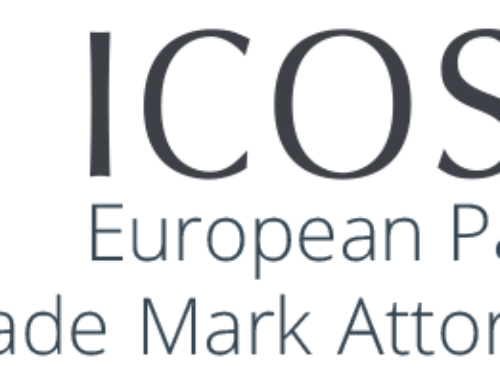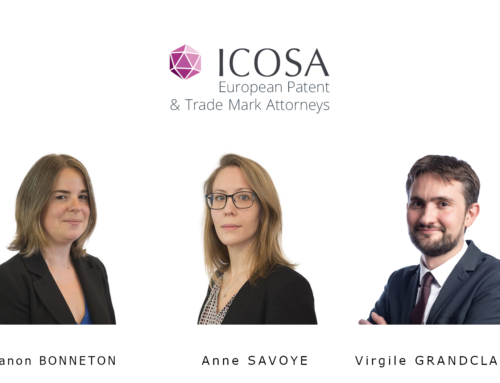Medical connected objects:
a highly valued intellectual property!
French start-ups show great capacity for innovation in connected objects, particularly in the field of health. How to value this innovation? What are the legal tools that carry value?
You can download the pdf for a later reading of this article, by clicking the button below.
About autors
Caroline de Mareuil-Villette and Claire Verschelde, Ph.D., French, Belgian and European patent attorneys, have been associated with ICOSA (an industrial property firm specializing in medical devices, life sciences and chemistry) since 2009. In addition to its patent expertise, ICOSA has developed expertise in software protection, database law and copyrights to meet a strong demand for the protection of connected objects in the field of health.

Caroline de Mareuil-Villette,
Founding Partner

Claire Verschelde,
Founding Partner
Connected objects are featured: at the gigantic US Consumer Electronics Show (CES), no less than 900 exhibitors exhibited connected objects. In terms of health, a 2013 McKinsey study announced a market of $ 1.1 trillion to $ 2.5 trillion per year by 2025, according to this study, the ultimate innovation in remote treatment and follow-up of patients with chronic diseases, thanks to super-efficient connected sensors.
Our health is a major goal for the manufacturers of connected objects: from the connected watch or smartphone that record our sports performance, our heart rate or the quality of our sleep, connected objects are likely to play an increasing role in the management of our health. The most technological are connected pacemakers or capsules that are swallowed and contain cameras capable of filming the state of the esophagus or intestine.
In this technological revolution, patents play a large role. The incessant pace at which large companies buy technology start-ups specialized in connected objects requires start-ups to value innovation through the best existing tools: intangible assets, i.e. patents, designs, databases, software, copyrights and trademarks.
Intellectual property, a key asset for connected medical devices
Patenting a connected object is not always easy and must take into account existing case law.
In Europe, a patent is a technical solution to a technical problem. This solution can implement a computer program, but cannot be a computer program alone.
In the United States, since Alice Corp. v. CLS Bank, the US Supreme Court has made a distinction between inventions that are not patentable because they refer only to an abstract idea, and patentable inventions, which bring an inventive concept by integrating the abstract idea into a concrete realization, thus resulting in a significant contribution much more important than the abstract idea itself. The application of this decision by the US Patent Office (USPTO) is turning into a real headache, and the patent application writer must anticipate these objections to patentability by intelligently presenting how the IT solution is to make a concrete, new and inventive contribution to the state of the art. But there is no connected object without collections of data: the right of databases, which is an independent right, sui generis, sees its importance multiplied by the stakes of Big Data.
Finally, who says object immediately thinks of a design.
Know-how: valuing the intellectual property of connected medical devices
Being able to set up a portfolio of intangible assets is one of the qualities expected of the entrepreneur of the technological start-up: all the wealth of the start-up is there, and it is up to him to know how to capitalize. Identify what is valuable in the work of the technology team, understand that the establishment of the data collection can be a source of income, have set up valuable databases, request the creation of strong graphical interfaces and managing copyrights, protecting source code for software, creating original designs, juggling secrecy, know-how and patenting – these are the strategic issues for these connected-object start-ups.
Valuing a portfolio of intangible assets is the procedure prior to any acquisition, any fundraising, and meets specific rules:
- define the valuation perimeter,
- distinguish essential assets from ancillary assets,
- know the strengths and weaknesses of these assets,
- identify the risks associated with development,
- set up a development schedule that is credible and consistent with the business plan,
- predict the penetration and development of the market,
- ensure distribution channels.
Market comparables are numerous and need to be referred to, while being cautious relative to higher valuations.
At the moment, the major players in the market are competing on this high-potential market, which is just beginning to open, and the highest valuations are reaching new heights:
- Google has acquired Nest for over $ 3 billion, and Qualcom has acquired CSR for over $ 2.5 billion,
- Cisco has invested $ 1 billion in various start-ups and is announcing new acquisitions.
This does not mean that all start-ups of connected objects will be able to value at such high prices, but the number of transactions shows very clearly that the market for mergers / acquisitions of start-ups of connected objects is extremely active.
Standards: a major challenge
Finally, it is almost certain that the connected objects industry will go through the paths opened by the telecommunications industry. At the moment, many competing systems are clashing. But with the development of connected objects, the standardization of networks will become necessary, as was the case for smartphones, and similar issues of Industrial Property may well arise. Some patents will become so-called essential patents (SEPs), that is to say patents that claim an invention that is mandatory to implement in order to comply with the applicable standards; the different players will have to find the conditions under which the licenses will have to be concluded: what is called in the telecom sector the FRAND conditions (fair, reasonable, and non-discriminatory).
One wonders who will choose the standards for connected medical devices: will it be the states, through the hospital structures, in a desire to combine telemedicine and connected medical devices?
Will the European Union be able to seize this subject at the dawn of this major change in life and habits that we see emerging?
The proposals will certainly come from private companies, Asian or American, dominating the medical devices sector. The stakes are incredibly important.






